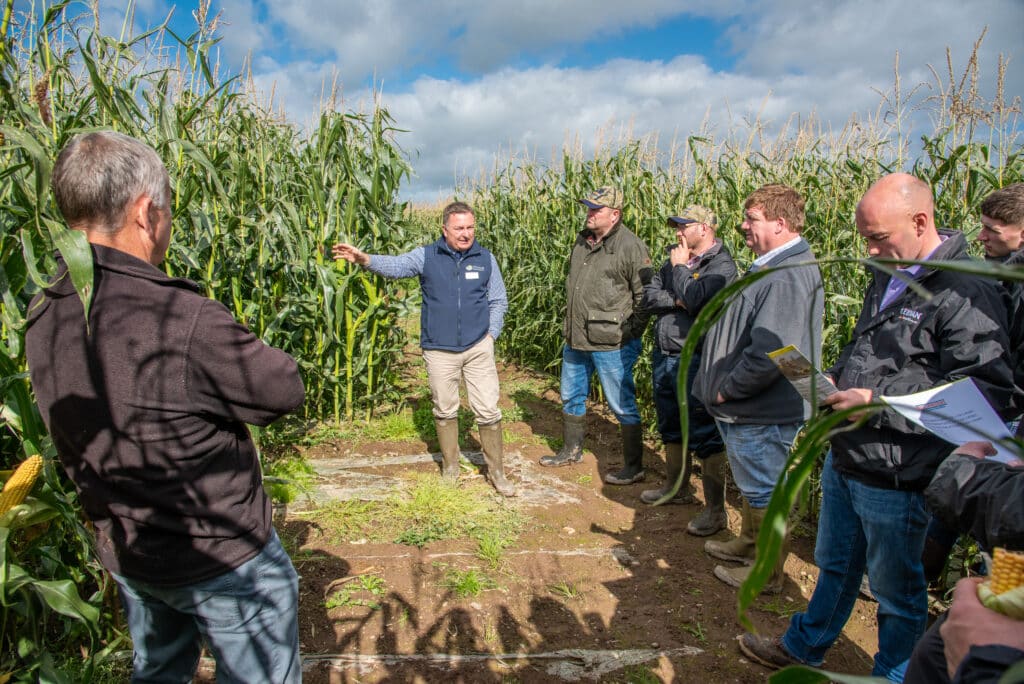The importance of drilling date in maize variety decisions – Farmers Guide
The latest season at Hutchinsons' northern maize trials underlined the importance of tailoring variety to drilling date ...
The trials were hosted by the Fisher family at Smalmstown Farm near Carlisle. Poor weather characterised much of the 2024 season, which saw the latest-ever drilling of maize trials on 8th May, and also the latest harvest in mid-October, according to Hutchinsons agronomist, Jim Clark. Generally, that reflects what was seen in the field too.
Variety differences shine through
Differences in varietal traits, notably speed of establishment and maturity, were particularly evident this year. In many cases, there was a 10-week drilling window for maize from April to the first week of June.
P7326 has dropped off the radar for some after several years on the market, but is one of the earliest maturing varieties when grown under film, with an earlier FAO maturity rating than P7034, and is potentially better suited to late- sowing situations than the popular P7034, Jim says.
The Bayer varieties (DKC3204 and DKC3218) stood out in the 2024 trials for their early vigour, and proved popular with visiting farmers. Experience with the varieties in Hutchinsons trials also suggests they are slightly earlier maturing than their official FAO ratings indicate.
“For instance, DKC3204 has a rating of 210, but from what we’ve seen in the field, while it is slightly later, we think it’s actually closer to P7034, which is rated nearer 180-190.”
Open crops
Open ground crops in the trials suffered significant damage by rooks and seagulls during establishment, making it hard to read too much into yield results. However, previous trials and experience on other farms in the area shows Prospect remains a good performer when grown in the open. But while it does well sown early in the open, experience shows the variety can struggle when grown under film. “We think the cut-off for sowing crops in the open is around 10-15th May, up here. If you’re drilling after that, you should go back to putting maize under film to help crops catch up. Prospect isn’t best suited to that situation [under film], so you are better going with a variety like P7179 or P7326”
Placement fertiliser benefit
Placing a smaller quantity of microgranular fertiliser with seed at drilling offers cost savings over traditional DAP applications, and improved nutrient use efficiency, which benefits rooting, establishment, and yield potential.
This was evident in the trials, where DKC3204 sown with Primary-P, for example, went on to produce a dry matter yield of 1.22t/ha more than the same variety without placement fertiliser. At a milk price of 45p/litre, this extra DM yield was worth an additional £887.20/ha. Another product, Crystal Green, also gave a DM yield benefit, worth more than £700/ha in additional milk value. “A lot of local contractors are now getting on board with placement fertiliser, and many say it is also easier to use than DAP,” notes Jim.
Undersowing
Undersowing maize with grass or crimson clover mixes is increasingly popular among maize growers, offering several benefits to soil health and the wider business.
Jim says last year’s undersowing trials at Carlisle were a great success. Using disc drills to sow grass into maize ground worked particularly well, and was a ‘step-up’ in establishment. However, because grass must be sown before maize gets too large (e.g. 6-8 leaf stage), the team found the vigorous Westerwold mix can grow too big.
“If we’re going to use mechanical drills to sow grass in maize early, we’ll probably have to look for a slower- maturing grass. In contrast, where the Westerwold mix is broadcast into standing maize as late as you can travel through with a fertiliser spinner, we need that vigour because the grass is going in so much later and has to reach a certain size before maize shades it out.”
When drilling grass into maize, growers must recognise any risks from pre-emergence grassweed herbicides. “You want as big a gap between herbicide application and sowing the grass as you can get. That window wasn’t massive this year, because once the maize gets too large, you can’t use a mechanical drill.”
Looking at seed rates for undersowing, he says 7.5-10kg/ha (3-4kg/acre) of Westerwold did provide reasonable cover, but for farmers wanting to graze land with sheep once maize is taken off, rates should be nearer 17-20kg/ha (7-8kg/acre).
